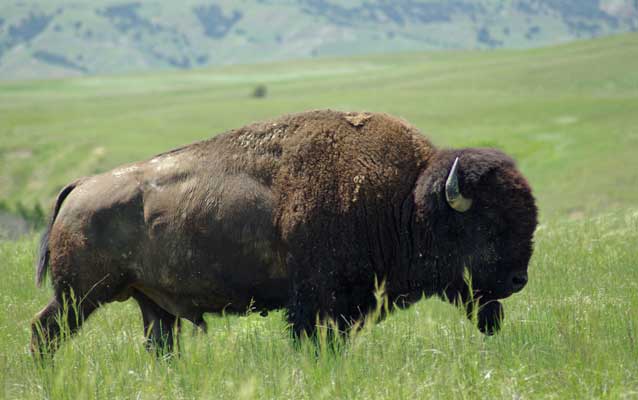Last updated: September 11, 2024
Lesson Plan
Bison Banquet: Food Chains and Food Webs of the Prairie

A male bison standing in the prairie.
NPS photo
- Grade Level:
- Upper Elementary: Third Grade through Fifth Grade
- Subject:
- Science
- Lesson Duration:
- 60 Minutes
- Common Core Standards:
- 3.RI.1, 3.RI.3, 5.RI.7, 5.SL.5, 3.W.1
- State Standards:
- NATIONAL/STATE STANDARDS:
SD Life Science Standards: 3.L.3.1, 3.L.3.2, 4.L.3.1
Essential Question
How does the Lakota concept of Mitákuye Oyás'iŋ (All Are Related) apply to prairie food webs?
Objective
Students will identify the components of a prairie food chain and prairie food web. Students will be able to illustrate the transfer of energy in both a food chain and a food web.
Background
A food web shows how energy is transferred in the environment. Energy is transferred from the Sun to plants, then to herbivores (plant eaters), then to carnivores (meat eaters).
The mixed-grass prairie ecosystem of Badlands National Park is home to a variety of plants, herbivores, and carnivores. Herbivores such as grasshoppers and rabbits eat grasses like ricegrass and wheatgrass. Meanwhile, birds like the meadowlark and the golden eagle prey upon the herbivores. As is the case in most ecosystems, plants and herbivores can be energy sources for many different animals.
Preparation
These materials are currently being reevaluated. Updated materials will be uploaded when they are ready to share.
Lesson Hook/Preview
All life needs energy to grow and survive. Plants receive their energy from the sun, while animals receive their energy by eating plants or other animals. The path energy takes through a series of organisms is known as a food chain, while the various paths energy can travel through an ecosystem is known as a food web. Discover how the mixed-grass prairie plants and animals of Badlands National Park are connected to each other through food chains and an overall food web.
Procedure
#1: Show where Badlands National Park is on a map. Help students understand where the park is in relation to their home by showing a map wiht the travel time to the park displayed.
#2: Explain that Badlands National Park is a unique place. Badlands is unique because it protects one of the largest mixed-grass prairie ecosystems remaining in the United States. Ask the students the following two questions and record their answers on the board:
-
What is a prairie? (North American grassland, usually flat to gently rolling and with few trees)
-
What animals or plants do you think live in a prairie habitat? (Some of the many possible answers are: bison, mule deer, prairie dogs, coyotes, swift fox, rabbits, eagles, hawks, snakes, insects, lizards, pronghorn antelope, coyotes, Mountain Blue Bird, Big Horn Sheep, Prairie Rattlesnake, mice, chokecherries, buffaloberries, buffalo grass, blue gramma grass, and wildflowers.)
#3: Discuss how all living things need energy. Where does a person's energy come from? (Food) What about a plant? Does it eat? Where does its energy come from? Illustrate a simple food chain on the board, drawing arrows to show the direction of energy transfer.
Sun à Grass à Rabbit à Golden Eagle
#4: Have students brainstorm one or more examples of a prairie food chain featuring animals that live in the Badland. Illustrate the food chain(s) on the board. To provide scaffolding for students who do not know which animals live in the mixed-grass prairie, you can provide a sample list of plants and animals for the students to select from. Use the list of animals and plants from step #2.
#5: Introduce the idea of food webs. A food chain shows one specific route that energy can take through an ecosystem, like one path you could walk to get from your home to school. A food web is like a map of the neighborhood that shows all the possible ways you could get from home to school. Food webs show how all the different species in an area can interact with each other to meet their energy needs. Most species don't get their energy by eating just one thing. For example, a coyote may eat many different small mammals, insects, carrion (dead meat), and plant matter.
#6: Hand out the Prairie Food Web Worksheet. Have students draw arrows between various members of the food web to show where they get their energy. Students may also draw in one or two additional plants or animals that live in the Badlands and fit them into the food web.
#7: Discuss what happens if part of the food web is disturbed. What if there is a bad drought? What if a species goes extinct? Can people have an effect on the food web? Help students make the connection back to the Essential Question regarding how all things are related.
Vocabulary
-
Ecosystem – a biological community of interacting organisms and their environment
-
Producer – creates energy from the sun, also called an autotroph
-
Consumer – eats or consumes plants or animals for energy needs, also called a heterotroph
-
Decomposer – obtains energy by breaking down dead or decaying organisms
-
food chain – a way of showing links in the food web starting with producers and ending with apex predators, decomposers, or detrivores that represent only one way energy could move through a food web
-
food web – a system of interlocking and interdependent food chains
-
detrivore – an animal that feeds on dead organic material
-
carrion – decaying flesh of dead animals
-
autotroph – produces energy from the sun
-
heterotroph – obtains energy by eating plants or animals
Enrichment Activities
These resources are available through Badlands National History Association (BNHA), a not-for-profit organization established to support education and research efforts at Badlands National Park.
- America's Prairie and Grasslands by Marianne D. Wallace
- Local Tracks of North America "Quick Guide"
- Golden Guide: Mammals
- Badlands Suite: Land of Stone and Light, From Field to Lab, Multiple Perspectives DVD
